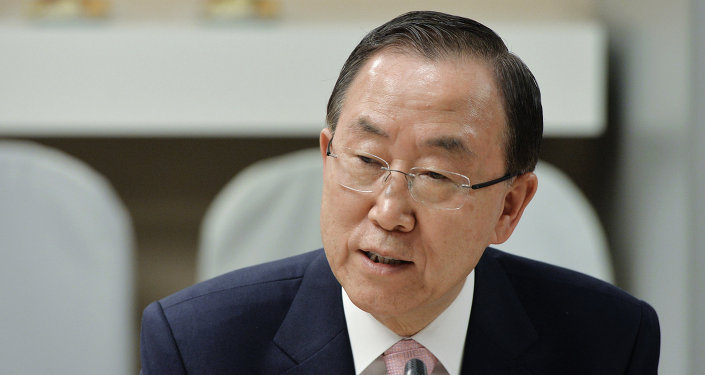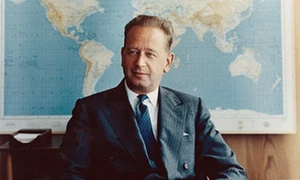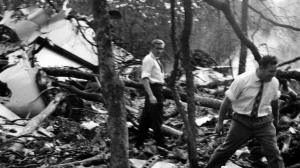Media Reports
Russian State Television - Russia (Russian)
Переклички истории: как упал самолет второго генсека ООН
На этой неделе в одном из самых загадочных происшествий XX появились новые подробности. Речь идёт о гибели второго по счёту генсека ООН Дага Хаммаршёльда. В 61-м году его самолёт разбился в Африке. Официально объявили, что крушение . результат трагического стечения обстоятельств. Сейчас выяснилось, что самолет с большой долей вероятности был сбит.
New York Times - USA
THE NEW YORK TIMES
LETTER FROM EUROPE
Panel Questions Whether West Tapped U.N. Chief's Communications
By ALAN COWELL JULY 10, 2015
LONDON — When a panel appointed by the United Nations reported this week on one of Africa’s most enduring mysteries, its findings raised an intriguing question: In the days before the plane crash that killed Dag Hammarskjold in 1961, were Western intelligence agencies bugging the encryption device he used to communicate with his headquarters in New York?
Given the massive, clandestine harvesting of data in the digital era, including revelations that the National Security Agency surreptitiously monitored the phone conversations of French and German leaders, the idea of eavesdropping on the United Nations secretary general might raise few eyebrows. Even in 2004, a British lawmaker, Clare Short, accused her country’s spies of listening in on Kofi Annan, one of Mr. Hammarskjold’s successors.
But, even though it seemed little more than a footnote in the panel’s exhaustive 91-page report, the newest suggestion that Mr. Hammarskjold’s Swiss-made CX-52 encryption device may have been compromised seemed to point once more to the catalog of hidden narratives compiled by intelligence agencies over the years and jealously guarded from the prying eyes of the public.
Indeed, the three-member panel, and Ban Ki-moon, the incumbent secretary general who appointed the commission, both buttressed calls for further investigation with appeals to intelligence agencies to, as Mr. Ban put it, “disclose, declassify or otherwise allow privileged access to” their secret files. “This may be our last chance to find the truth,” he said.
It could be a very slim chance indeed. Citing security considerations, British and American officials declined to declassify information sought by the panel, although the United States permitted one of its members to take a peek at two classified N.S.A. documents to establish that they “do not contain information which would shed light” on the crash.
Nonetheless, it is tempting to ask what secret could be so great — almost 55 years after the fact — to justify the continued cloud of obfuscation surrounding Mr. Hammarskjold’s death and the maneuvers of great powers intent on molding Africa’s destiny to their political and economic will at the height of the Cold War.
Mr. Hammarskjold’s DC-6B airliner crashed on the night of Sept. 17-18, 1961, just outside Ndola in what was then Northern Rhodesia and is now Zambia. He was on a peace mission as fighting raged between secessionist troops backed by mercenaries in the neighboring Congolese province of Katanga and United Nations forces sent to subdue their revolt. Mr. Hammarskjold was flying into a maelstrom.
In its report, the panel said enough new information had come to light in recent years to suggest that the airplane could have been brought down deliberately. It also assigned “moderate probative value” to assertions that Western officials may have conspired to cover up key elements of the story.
The panel concluded that there was some evidence to support the assertion that the CX-52 encryption device may have been “among those intentionally designed such that their transmissions could be surreptitiously intercepted by the N.S.A. and other select intelligence agencies.”
While Mr. Hammarskjold sought to keep his itinerary secret, his own messages “if intercepted, could have provided information about the travel and other arrangements being made” for his scheduled encounter in Ndola with Moise Tshombe, the leader of the Katangese secessionists.
In the climate of the time, when many of Mr. Tshombe’s sympathizers and Western sponsors regarded Mr. Hammarskjold as their worst enemy, that would have been valuable information.
The panel’s evidence relating to the encryption device came from Sixten Svensson, the Swedish brother-in-law of the founder of the Swiss company that produced it, who died in the 1980s.
According to Mr. Svensson in a telephone interview on Wednesday, one of the last messages sent using Mr. Hammarskjold’s encryption device on Sept. 17, 1961 — hours before he flew to Ndola — set out his tentative schedule and chronicled his expectation of a “favorable reaction.” But the stakes were high. Had he survived to test Mr. Tshombe’s sentiment, Africa’s history might have taken a different course altogether.
ABC Nyheter - Norway
From ABC Nyheter (Oslo)
UN rejects Norwegian murder theory
Original here
9 July A Norwegian General claimed that the Head of the UN Dag Hammarskjöld had a bullet wound in the forehead and that the pictures of the deceased was later on manipulated. This is rejected in a new UN investigation of the air crash in 1961. The mystery around Dag Hammarskjöld´s death continues to puzzle. Last week a new UN commissioned Panel produced its report on events at the time of the air crash in 1961.
The UN-investigators recommend that investigations should continue as there seems evidence that supports the theories that the aircraft was shot or forced down in the tree tops in what was then Northern Rhodesia (today Ndola is situated in Zambia). "The findings are strong enough that one should continue the investigation of a possible air attack or other influence," says the statement from UN Secretary General, Ban Ki-moon.
Newly presented are certain witness statements which were rejected in 1961 based on racial motives when the apartheid state Rhodesia investigated the case. But the first seven pages of the 64 page Report are used to reject the allegations from two Norwegian sources, including statements from the late Major-General Björn Egge about how Hammarskjöld died.
Rejects bullet hole
Major General Egge thought Hammarskjöld survived the air crash and was shot later on. He was the first UN-officer who saw the deceased at the Ndola hospital, and said later that he saw a bullet hole in the forehead of the highly respected Swedish UN top official (sic). Egge, Lieutnant Colonel at the time, was the one that formally identified Dag Hammarskjöld. He was there as a communication officer with UN peace keeping forces. The UN Panel stated that the medical report and X-rays do not support the bullet hole allegation, though they criticise the quality of the documents compared to today´s standard. In later interviews, Egge nuanced his opinion concerning a bullet hole in the forehead, but this is not referred to in the UN Panel’s report.
Retouched pictures
The investigation rejects the bullet-hole story and also claims by the Norwegian-Swedish writer Bodil Katarina Nævdal. In her book about Trygve Lie and Hammarskjöld Drømmenes palass (2009), she writes that photographs of the deceased were later manipulated. She was not contacted by the UN Panel during their work and she has not read their report. In it, they state they were unable to find negatives or original pictures from the crash site or hospital, so they cannot confirm the allegation about retouching. “That was probably a mistake, but I got the pictures from the Royal Library where they are excluded from publicity for ever” says Nævdal. She refers to the newly retired head of the photo section at KRIPOS (Norwegian police criminal investigation group) Ask Rojahn who had sight of the photos at the time of the book release when it was claimed for the first time that the pictures were manipulated. “The pictures I saw came from Sweden and they were retouched” says Rojahn to ABC Nyheter. He underlines still that this is not unusual for pictures which are to be presented for relatives in situations where identifications is required, while the investigators themselves keep the not retouched copies.
Rojahn had not seen negatives
“If it was a bullet hole, a tear or a bad mark retouched, one could not see. But there were pictures from a coroner’s inquest. There one could see that a shadow that fell naturally from the side, was broken” says Rojahn.
The UN Report states that the UN Panel could not find Rojahn to question him even though he is mentioned in Nævdal´s book. Instead, it is claimed, they were satisfied with a ten year old article in Afteposten. Separately, Ms Nævdal says she has recently found information in South-African archives and that these have been passed to the UN via Swedish police. This has not been confirmed by RIKSKRIM (Swedish police) in Stockholm when ABC Nyheter spoke to them on Wednesday afternoon.
ABC Nyheter has tried to reach the Danish expert member of the UN Panel, Henrik Larsen, a ballistic expert connected to the Danish Rigspolitiet (Danish State police) but failed to secure a statement.
Fox News - USA
FOX News
Panel reports new information about possible aerial attack on Dag Hammarskjold plane in 1961
Original here
6 July An independent review of new information about the mysterious 1961 plane crash that killed U.N. Secretary-General Dag Hammarskjold puts to rest claims that he was assassinated after surviving the crash but provides new information about a possible aerial attack or interference.
U.N. Secretary-General Ban Ki-moon called for a further inquiry or investigation in a letter to the U.N. General Assembly circulated Monday saying some countries believed to have information about the crash didn't provide "a substantive response," didn't respond at all or maintained that documents were classified.
Widely considered the U.N.'s most effective chief, Hammarskjold, a Swedish diplomat, died as he was attempting to broker a cease-fire in the newly independent Congo. It's long been rumored that his DC-6 plane was shot down, and an independent commission set up to evaluate new evidence surrounding his death recommended a fresh investigation in September 2013, citing radio intercepts held by the U.S. National Security Agency as the possible key to solving the case.
The General Assembly late last December asked Ban to appoint an independent panel to review new evidence. Its report released Monday gave a "moderate" value to information from nine of 12 new eyewitnesses who reported on the final stages of the flight before it crashed near Ndola Airport in modern-day Zambia, then Northern Rhodesia.
The three-member panel said the nine eyewitnesses helped establish one or more of the following: there was more than one aircraft in the air as Hammarskjold's aircraft approached the airport, the aircraft were jets, the secretary-general's DC-6 was on fire before it impacted the ground, and his aircraft "was fired upon or otherwise actively engaged by other aircraft present while approaching Ndola."
The panel also gave a "moderate" value to claims by two Americans — Charles Southall, a former U.S. Navy commander, and Paul Abram, a former U.S. Air Force Security Services officer — who either listened to or read a transcript of an intercept of radio transmissions the night of Sept. 17-18, 1961, which they believe was reporting an attack on Hammarskjold's plane that resulted in the crash.
The 99-page report states that the United States and Britain retain some classified files and says South Africa has not responded to several requests for information.
Among the new information made available to the panel by the independent commission was a report that an alleged agent for Britain's foreign intelligence agency MI6, Neil Ritchie, transported Moise Tschombe, leader of Congo's secessionist Katanga province, to Ndola on Sept. 17, 1961, to meet Hammarskjold.
While the report doesn't comment on the possible cause of the crash, the panel said it provides new information about the presence of the British intelligence agency in the area. It added that Britain has refused to release these files.
The panel said it also investigated sabotage as a possible cause of the crash and while there was no evidence of an explosion while the plane was in flight it received several pieces of new information that relate to the possibility that the DC-6 crashed as a result of sabotage.
It cited eight documents in a file that the South African Truth and Reconciliation Commission received from the country's National Intelligence Agency relating to the 1993 assassination of Chris Hani, leader of the South African Communist Party, which purported to be internal correspondence of an organization allegedly engaged in clandestine mercenary activities in and around Congo and elsewhere in the early 1960s.
Documents from the organization, the South African Institute for Maritime Research, refer to an "Operation Celeste," purportedly to "remove" Hammarskjold with cooperation from then U.S. CIA director Allen Dulles, and note that the U.N. secretary-general would be in Leopoldville on or about Sept. 12, 1961, the panel said.
One document refers to a Belgian mining company providing explosives and detonators and another indicates the device failed on takeoff but activated prior to landing and ends "Mission accomplished: satisfactory," it said.
The panel said it has received no response from the South African government to its request for information, records, or references about the existence and activities of the organization that would either negate or corroborate the purported plan.
Wall Street Journal - USA
UN SECRETARY-GENERAL PRESSES PROBE INTO FORMER CHIEF'S DEATH IN 1961
Ban Ki-moon cites new evidence surrounding the crash that killed Dag Hammarskjöld
U.N. Secretary-General Ban Ki-moon, shown in the Norwegian government's official residence in Oslo on Monday, is seeking classified information from the U.S. and other countries that might shed light on the unsolved mystery of Dag Hammarskjöld’s death. PHOTO: GROTT/NTB SCANPIX/ZUMA PRESS
By JOE LAURIA
July 6, 2015 10:58 p.m. ET
UNITED NATIONS—U.N. Secretary-General Ban Ki-moon asked the General Assembly to open a full-scale probe into the plane crash that killed former U.N. chief Dag Hammarskjöld in 1961, after an independent panel reported Monday that evidence recently uncovered was worth investigating.
The panel reported that the continued refusal by intelligence agencies of the U.S. and other governments to declassify documents may be hindering the “final revelation” into what caused the crash. The panel recommended Mr. Ban continue to urge governments to disclose or declassify the documents, or allow him “privileged access” to information the governments may possess about the circumstances of Mr. Hammarskjöld’s death.
“I note … that in some cases, member states have not provided a substantive response, have not responded at all or have maintained the classified status of the documents in question despite the passage of time,” Mr. Ban said in his letter to the General Assembly. “I intend to follow up with the member states concerned.” The secretary-general said he’s appointed a special counsel to interact with U.S. and other intelligence agencies.
Mr. Hammarskjöld was killed on his way to Northern Rhodesia—now Zambia—when his Swedish DC-6 airliner plunged into a forest 9 miles from his destination in the city of Ndola on Sept. 18, 1961.
Wreckage of the DC-6 plane crash that killed Dag Hammarskjöld and the other 15 people aboard near Ndola, Zambia on Sept. 19, 1961. Mr. Hammarskjold was on his way to a meeting with the Katanga leader Moise Tshombe to negotiate a peace agreement. PHOTO: ASSOCIATED PRESS
He was on his way to negotiate a peace agreement there with Moise Tshombe, leader of the separatist Katanga province in the newly independent Congo. Mr. Hammarskjöld supported the spreading anti-colonial movement in Africa at the time and opposed mineral-rich Katanga leaving the Congo. U.N. troops were fighting Katanganese mercenaries about 100 miles away as Mr. Hammarskjöld was about to land.
Why the plane crashed has never been established.
A 2011 book “Who Killed Hammarskjöld?” by British researcher Susan Williams revealed significant new evidence about the crash and inspired an independent commission that recommended in 2013 that Mr. Ban either reopen an inconclusive 1962 U.N. investigation or start a new one. The secretary-general asked the U.N. General Assembly to create a panel to look into the new evidence, which the assembly did in December. Both Mr. Ban and the assembly, in a resolution backed by the U.S. and U.K., urged governments to declassify any information pertinent to the case.
The panel reported that it received only limited cooperation from U.S. intelligence agencies. It said the truth about what happened to Mr. Hammarskjöld’s plane would still require the U.N. to further “critically address remaining information gaps,” including what may be contained in classified material and other information held by member governments.
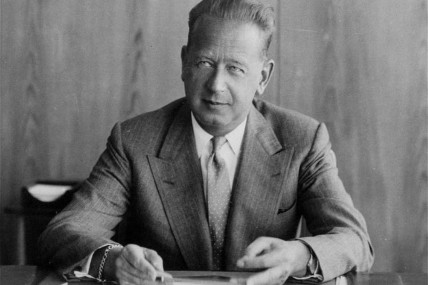
Dag Hammarskjold, secretary-general of the United Nations, in 1959. PHOTO: ASSOCIATED PRESS
The panel’s report dismissed an array of the new evidence, including information suggesting that the plane may have been hijacked, accidentally shot down by a pilot trying to divert it, or that a bomb was placed on board. Using medical records from the time, the panel also rejected accounts that Mr. Hammarskjöld and the other 15 people aboard who were killed had been shot either on the plane or on the ground.
But the panel didn't dismiss evidence that the plane may have been deliberately shot down. The three panel members traveled to Ndola to interview witnesses of the air disaster who told them they had seen a second plane near Mr. Hammarskjöld’s, and that the DC-6 had been set on fire before it went down.
The panel also examined accounts by Charles Southall and Paul Abram, two American servicemen working for the National Security Agency on the night of the crash, who said they heard intercepted radio transmissions indicating Mr. Hammarskjöld’s plane was shot down.
Although he worked for the NSA, Mr. Southall told The Wall Street Journal the intercept was over a Central Intelligence Agency circuit. The CIA declined to confirm or deny the existence of any intercept following a Freedom of Information Act request by The Journal. The agency upheld its decision after The Journal appealed it. The NSA told the independent commission that reported last year that it had no record of the Southall incident.
The NSA had one related file declassified. It was a cable sent by then-U.S. Ambassador to Congo Edmund Gullion hours after the crash, saying there was a possibility Mr. Hammarskjöld was shot down by a single pilot who had “harassed” U.N. operations, Mr. Gullion wrote. He identified the pilot as Belgian mercenary Jan Van Risseghem, who died in 2007.
The panel learned from the Belgian government that Mr. Hammarskjöld was aware of the danger posed by Mr. Van Risseghem. The secretary-general sent a telegram to Brussels two days before his fatal flight asking the foreign ministry’s help in “putting an end to Van Risseghem’s criminal acts against the U.N.,” the report says. Belgium then investigated and discovered that Mr. Van Risseghem had left Belgium to return to Katanga on Sept. 16, and wouldn't have arrived in time to carry out the attack, the report says.
Write to Joe Lauria at newseditor@wsj.com
Toronto Star - Canada
Toronto Star
Hammarskjold crash needs more scrutiny: UN report
UN panel unearths new evidence, including allegations of foul play from eyewitnesses who had not testified before.
AP / THE ASSOCIATED PRESS
Former UN chief Dag Hammarskjold, shown in 1953, had a hands-on approach to diplomacy and his determination to rise above member countries’ national interests drew enemies as well as admirers.
By: Olivia Ward Foreign Affairs Reporter, Published on Fri Jul 17 2015
Was it greed, a power play, ham-fisted colonialism or a warning gone horribly wrong?
Who killed UN Secretary General Dag Hammarskjold is a mystery as murky as any penned by a Swedish thriller writer.
This month, a UN panel concluded that a new investigation was needed into facts that were obscured or overlooked after Hammarskjold’s death. And it said that an aerial attack could be a possible cause of the crash.
The death of the world’s top diplomat, who perished in a plane crash on Sept. 18, 1961, en route to a crucial peace mission in Congo, was hastily declared an accident caused by pilot error. But over five decades, doubts have deepened.
Among the 15 others on the plane with Hammarskjold was 48-year-old Montrealer Alice Lalande, a UN secretary working for the world body’s chief of Congo operations.
But documents that may be vital to solving the mystery are still being withheld by countries like the U.S. and Britain, who had deep interests in Congo during its turbulent transition to independence. UN Secretary General Ban Ki-moon says he will ask them to share any “relevant information.”
The panel’s conclusion follows more than half a century of detective work, conspiracy theories and reports that suggest Hammarskjold’s untimely demise, at 56, was no accident — and that the plane was attacked by unknown assailants. But the aging and death of witnesses, the involvement of powerful players and the tightly tangled knot of the era’s politics make it ever harder to unravel the truth.
The new report picks up from a 2013 investigation concluding there was “convincing evidence” that the plane was shot down as it tried to land.
Headed by Tanzanian chief justice Mohamed Chande Othman, the panel brought to light evidence and allegations of foul play that were not in previous official reports, including nine accounts from African eyewitnesses who hadn’t testified earlier.
They claimed that “more than one aircraft” was near Hammarskjold’s plane as it made its approach to Ndola, in then Northern Rhodesia. The Swedish Transair plane, some said, was on fire before it crashed, and they reported hearing a loud noise before the plane went down.
Even more dramatic was the claim of former U.S. navy commander Charles Southall that while at a National Security Agency base on Cyprus he intercepted a transmission saying, “Yes, it’s the Transair DC6. It’s the plane. I’ve hit it. There are flames. It’s going down. It’s crashing.”
Paul Abram, a former U.S. air force officer working in Greece at the time of the crash, said he heard an unidentified radio transmission that “the Americans just shot down a UN plane.”
The UN report also cited new information on the Katanga administration’s air capability and use of foreign military and paramilitary personnel. It raised the possibility that Hammarskjold’s encrypted communications were intercepted.
Contrasting accounts of Belgian pilots who may have had a hand in his death, and an alleged CIA contractor who claimed to have been hired as a “hit man” have surfaced over the past decade, along with allegations that the crash was accidentally caused by warning shots to divert but not bring down the plane. Government secrecy has only stoked conspiracy theories.
There is no shortage of suspects.
Hammarskjold, named as the greatest statesman of the 20th century by U.S. President John F. Kennedy, was a rare activist among UN chiefs. Born to money and position, the son of a former Swedish prime minister, he was a key adviser on Sweden’s financial policy after the Second World War and a delegate to the UN.
In 1953 he was appointed UN Secretary General. But his hands-on approach to diplomacy, and his determination to rise above member countries’ national interests, drew powerful enemies as well as numerous admirers. He was awarded a Nobel Prize posthumously.
Will the latest report bring the Hammarskjold mystery any closer to conclusion? The UN General Assembly is studying it, and will decide where to go from here. It is only certain that almost everyone in this dark thicket of history has something to hide.
DAG HAMMARSKJOLD TIMELINE
Decades of doubt:
1961: In September Hammarskjold dies in an air crash in Northern Rhodesia — now Zambia — en route to peace talks with Congolese secessionist leader Moise Tshombe.
1961: InNovember the Rhodesian government announces the crash was due to pilot error. A second investigation in 1962 affirms the conclusion.
1962: InApril a UN inquiry results in an open verdict, saying pilot error was likely, but that sabotage cannot be ruled out.
1992: Two UN diplomats serving in Katanga before and after Hammarskjold’s death write letter to the Guardian newspaper claiming to have new evidence that the plane was accidentally shot down by mercenaries.
1993: A private inquiry for the Swedish government says the crash was caused by pilot error.
2005: Bjorn Egge, head of UN military information in Congo at the time of the crash, tells a Swedish paper he saw a round hole in Hammarskjold’s forehead when viewing the body, suggests a coverup.
2011: Susan Williams of the University of London publishes new evidence in a landmark book, Who Killed Hammarskjold?: The UN, the Cold War and White Supremacy in Africa.
2012: The independent Hammarskjold Commission is formed to determine whether the evidence about Hammarskjold’s death is sufficient to reopen a new inquiry.
2013: Commission’s report by four jurists agrees an inquiry is needed. UN Secretary General Ban Ki-moon directs the UN General Assembly to put it on the agenda. An independent panel is formed.
2015: An independent Panel of Experts reports to the UN that there is enough evidence of possible foul play to open an inquiry on Hammarskjold’s death.
Olivia Ward
Aero News - International
UN Receives Report On Accident That Fatally Injured Dag Hammarskjöld
Plane Went Down On A 1961 Peace Mission To Congo
Original here
21 June 2015 An independent panel of experts appointed by UN Secretary General Ban Ki-moon has delivered a report that examined a 1961 accident which fatally injured then-Secretary General Dag Hammarskjöld.
Hammarskjöld was on a peace mission to the newly-independent Republic of Congo when the DC-6 he was aboard went down in the African bush in Northern Rhodesia, which is now called Zambia. One of the issues the panel was charged with investigating was whether the plane was shot down.
In a statement posted on the UN website, The Secretary-General said the panel had submitted its report on its findings, conclusions and recommendations.
"The Secretary-General wishes to thank the Head of the Panel, Chief Justice Mohamed Chande Othman of the United Republic of Tanzania, and the other members of the Panel, Kerryn Macaulay of Australia and Henrik Larsen of Denmark, for their important contribution to the ongoing search for the truth about the conditions and circumstances related to the tragic death of the late Secretary-General, Dag Hammarskjöld, and the members of the party accompanying him on that fateful night of 17-18 September 1961," Ban Ki-moon wrote.
"The Secretary-General is pleased that the Panel visited Zambia to meet with new witnesses, and that it successfully gathered additional new information from Member States and other sources, including national and private archives in Belgium, Sweden and the United Kingdom.
"The Secretary-General will study the report carefully and expeditiously, and, subject to any considerations of a medical or private nature, will make the report of the Panel, as well as his own assessment and options on the way forward, available to Member States and the public as soon as possible."
VICE News - International
VICE News
What Does the UK Know About the Mysterious Plane Crash That Killed a UN Secretary-General?
For original, see here
By Katie Engelhart
July 23 On the evening of September 17, 1961, a plane fell out of the sky in British-ruled Northern Rhodesia, known today as Zambia. According to meteorology reports, the night was clear and calm.
On board the DC-6 airliner was the 56-year-old United Nations Secretary-General Dag Hammarskjöld — who was on his way, under the cover of night, to negotiate an urgent ceasefire.
The warring parties were many and varied. On the one side was the then Republic of Congo, which had just declared independence from Belgium, and its anti-colonial supporters. On the other side were secessionist forces in the province of Katanga — backed by mining executives, reams of mercenaries, and some high-up officials within American and European governments, all of whom were fighting to see Africa's colonial order maintained. Katanga had become a post-colonial maelstrom.
The stakes were high: in no small part because masses of radioactive uranium had been found in Katanga. Indeed, uranium from Katanga was used in the nuke that American forces dropped on Hiroshima. In 1961, in the thick of the atomic Cold War, the American government was desperate to prevent the Soviets from getting any of it.
But back to Secretary-General Hammarskjöld. His plane never landed. It crashed in the thick bushlands near Ndola and the youngest-ever UN secretary-general died.
In 1961 and 1962, the Rhodesian government claimed that Hammarskjöld and his fellow passengers had perished on impact in a crash caused by pilot error. But a 1962 UN inquiry reached an open verdict — and would not rule out sabotage.
All along, eyewitnesses disputed the official version of events. Several locals reported seeing two aircraft in the sky before the crash, with light or fire transferring from the smaller plane to the larger plane. Others claimed that they had visited the crash site and seen bullet holes in the aircraft.
And so opened one of the great, unsolved mysteries of the Cold War era.
Last week, the United Nations published a much-anticipated inquiry into the crash and the deaths of 16 passengers. In the report, UN investigators said that they had found "significant
new information" supporting the theory that Hammarskjöld's plane was downed by "aerial attack or other interference."
The report followed months of investigative work. A three-person "Independent Panel of Experts" combed through historic archives and interviewed handfuls of experts, and traveled to Zambia to speak with 12 living eyewitnesses to the crash. The report offered no conclusive findings, but it did cast doubt on official versions of events — to the delight of conspiracy-minded Hammarskjöld watchers.
In a letter dated July 2, current UN Secretary-General Ban Ki-moon personally recommended a further investigation into the incident: "This may be our last change to find the truth."
The leading theory is that Hammarskjöld's plane was shot down, by opponents of his anti-colonial stance in Africa. Perhaps the shooters were mercenaries fighting for Katanga on behalf of Belgium. Or perhaps, they were employees of rich European mining companies that had lucrative stakes in the Katanga province and feared losing their concessions.
Other think the crash was the product of great power machinations. In 2013, an international commission of distinguished jurists, chaired by the Hammarskjöld Inquiry Trust, reviewed evidence "that a group representing a number of European political and business interests [had] wanted the secretary-general's plane diverted from Ndola... in order to persuade him of the case for Katanga's continued independence."
1961, after all, was a time of continental reinvention that had been long anticipated, but bitterly resisted, by Europe's moribund colonial powers. Everyone wanted a piece of the post-colonial break-up and parts of Africa, including the Congo, had become proxy battlegrounds for larger, Cold War disputes. Hammarskjöld, who supported independence for African states, was making life difficult for Europe's collapsing colonies.
But absolute truth may prove illusive in this instance, at least for Mr. Ban. A number of UN member states — including the US, UK, Belgium, and South Africa — will not play ball with UN investigators. Namely, these member states have refused to hand over historic government documents, which could shed light on the long-ago crash.
The US has already been singled out by critics who allege that it is covering up evidence about the CIA and NSA's former involvement with Katanga secessionists.
Thus far, the UK has largely escaped scrutiny — despite the fact that it too has refused to hand over uncensored state files.
This is troubling to UN investigators, especially given that newly discovered historical documents place at least one British intelligence agent in the Ndola area at the time that Hammarskjöld's plane came down.
On April 27, the UN Hammarskjöld's panel wrote to the UK Foreign & Commonwealth Office (FCO), asking whether the British government had any undisclosed information that might aid its investigation.
On June 10, two days before the panel concluded its work, the FCO replied with a sparsely worded email, explaining that it had "co-ordinated a search across all relevant UK departments. None of these departments has identified any pertinent material."
But what does "relevant" mean?
And, importantly, were the British intelligence agencies MI5, MI6, and UK Government Communications Headquarters (GCHQ) included in the "search"?
VICE News contacted the FCO, asking for further clarification. But an FCO spokesperson would say only: "It is the longstanding policy of successive British governments not to comment on intelligence matters." The UK Home Office also refused to comment, referring VICE News back to the FCO.
The thing is, nobody in Britain comments on intelligence matters.
In the UK, intelligence and security agencies do not fall under the Freedom of Information Act — so it is impossible to compel the agencies to release information to the public. By contrast,
the American CIA, FBI, and NSA can be subject to Freedom of Information requests. In fact, MI5 and MI6 do not even have press offices that can answer queries from journalists.
VICE News also contacted the GCHQ, which would not comment on whether it had been included in the Hammarskjöld's panel search. But the department did invite VICE News to submit a Freedom of Information request on the matter, so that GCHQ could formally decline the Freedom of Information request, on the grounds that GCHQ is not obliged to respond to Freedom of Information requests.
Related: Here's What the British Government Has Been Hiding
Among the British documents that are of interest to UN officials is a report from a British High Commission official and MI6 official Neil Ritchie, dated September 17, 1961. In the report, Ritchie describes how he personally transported a Katanga leader to Ndola to meet with Hammarskjöld.
The document, which was discovered by historian Dr. Susan Williams in a private archive at the University of Essex, does not reveal the cause of the crash — but it does prove that UK intelligence was working in the area at the time and keeping records of its work.
The UN panel was also interested in six slim files that are held at the UK National Archives, which have been publicly released, but with redactions. One is titled: "Enquiry into circumstances of crash of aircraft carrying Dag Hammarskjöld, UN secretary-general — 1962." Another is titled: "Activities of mercenaries in Belgian Congo — 1961."
The UN asked for uncensored versions of the documents, but the FCO said declined: "For security-related reasons."
At the same time, Foreign Office officials insisted that "the total amount of information withheld is very small."
In 1960 — one year after nationalist riots swept Leopoldville (now Kinshasa) — the Congo, a long-time Belgian colony, declared independence.
But a month later, the secessionist leader Moise Tshombe proclaimed independence in the province of Katanga. Europeans began to flee the region and floods of mercenaries arrived.
This is where alliances get muddled. The UN voted to send troops into the region to maintain law and order. Hammarskjöld was sympathetic to Congolese independence aspirations, as were many Western powers — at least officially. But powerful elements within the US, Belgium, and other European states backed the Katanga separatists: with the hope that Katanga might act as a buffer and halt the southward spread of African nationalism.
The mining behemoth Union Minière du Haut Katanga (now Umicore) also backed Katanga as it was anxious to keep hold of the region's vast uranium and cobalt deposits.
So when Hammarskjöld's plane came down, many around the world suspected foul play — even if they couldn't decide quite who was acting foully, and why.
The wildest of rumors emerged. One suggested that the plane had been attacked with help from the Romanian Embassy in Leopoldville, on the orders of the Russian KGB. Another claimed that Hammarskjöld survived the initial plane crash, but then was assassinated by European missionaries.
Much of the UN panel report dismisses these claims as having "nil" probative value.
But the UN report addresses other theories with more cautious language: describing them as impossible to prove but also unwise to dismiss — notably, the claim that Hammarskjöld's plane was shot down by a Belgian mercenary known as the "Lone Ranger" who was committed to thwarting the UN's anti-colonial efforts. Belgium, after all, was at risk of losing its entire colonial prize.
Another theory — put forward in letters that were allegedly written by a clandestine South African mercenary agency, and released by the South African government in 1998 — purports that South Africa had carried out a determined operation to "remove" Hammarskjöld from office. The plot, known as Operation Celeste, allegedly had support from then CIA director Allen Dulles, who promised "full cooperation from his people," in addition to the Belgian
Page 4
Mining company Union Miniere. But the UN panel was unable to confirm the veracity of the documents: in part, because South Africa did not respond to the investigators' request for help.
Related: What would you do if you could censor your past? A visit to the UK's secret archives.
The reinvestigation into Hammarskjöld's death did not pick up pace until 2011, when British historian Susan Williams published a book called Who Killed Hammarskjöld? This contended that the original inquiry into the plane crash, carried out by the Rhodesian government, amounted to a cover-up. And it presented new evidence on the case.
After the book was published, an independent commission of legal experts concluded that there was "convincing evidence" that the plane had been shot down.
In 2013, that commission chastised the US for withholding relevant documents from international investigators. The commission insisted that it was "highly likely" that the NSA and CIA had been monitoring local and regional radio traffic on the night that the plane went down.
But when the commission filed a Freedom of Information request for NSA intercepts, the request was denied.
Two former US government officials also accused Washington of withholding evidence. One of them, navy commander Charles Southall, was working at an NSA installation in Cyprus on the night of the crash and he said he overheard radio transmissions suggesting that Hammarskjöld's plane had been subjected to an aerial attack.
On the night of the crash, Southall testified, a senior officer contacted him "at about midnight" and asked him to return to the communications facility where he worked, to witness "something interesting."
The new UN panel also points a finger at US uncooperativeness. Notably, UN investigators have revealed that Hammarskjöld's Swiss-made CX-52 cipher encryption device may have been bugged by the NSA — via collusion with the device's Swiss manufacturers. This would have provided the US government with access to Hammarskjöld's travel arrangements on the night of his death.
Related: Exclusive: The UK Has Just Unearthed New 'Top Secret' Colonial-Era Government Files.
None of this bodes well for the UN. After all, it cannot legally compel member states to hand over government files.
In fact, according to David Wardrop of the United Nations Association, a charity that analyzes UN activity, the UN has historically struggled with document sharing. For instance, Wardrop said, "there isn't a proper library of information at the UN" that gathers documents from prior peacekeeping missions — to shed light on lessons learned.
"Ban Ki-moon," argued Wardrop, "will have great difficulty in persuading states" to hand over Hammarskjold files, since nations generally resist intelligence sharing schemes.
But he will try. Early this month, Ban tasked UN Legal Counsel Miguel de Serpa Soares with pressing member states to reveal Hammarskjöld files.
Until they do, the idea that Hammarskjöld was murdered will be hard to put to rest — especially since the theory has, at times, been advocated at the highest government levels.
Soon after Hammarskjöld's crash, US President Harry Truman reportedly told the New York Times that the secretary-general had been "on the point of getting something done when they killed him. Notice that I said 'when they killed him.'"
This summer, representatives from the Harry S. Truman Presidential Library in Missouri told UN investigators that they have no documents that could explain Truman's comments. Follow Katie Engelhart on Twitter: @ka
CoastWeek - Kenya
United Nations probe 1961 plane crash of Dag Hammarskjold
by William M. Reilly UNITED NATIONS New York (Xinhua) -- There is sufficient reason to investigate if the aircraft carrying then-UN Secretary-General Dag Hammarskjold on an African peace mission in 1961 was shot down by another plane, killing all aboard, UN Secretary-General Ban Ki- moon has said.
A panel, which Ban established in March to examine new allegations regarding the crash, near Ndola in Northern Rhodesia, now Zambia, of the Swedish-operated Douglas DC6 carrying Hammarskjold and 15 others, recently sent its finding to the secretary-general who sent them on Monday to the 193-member UN General Assembly along with his recommendations to investigate some of the allegations further.
However, Ban said the panel determined Hammarskjold was not assassinated after surviving the crash and that there was no hijacking or sabotage.
The panel found Hammarskjold and 14 other passengers died on the night of the Sept. 17 to 18, 1961 crash of the propeller-driven aircraft. SE-BDY and the 16th victim died five days later.
Hammarskjold, the second UN secretary-general, was trying to negotiate a cease-fire involving secessionists from Katanga province of the Democratic Republic of Congo.
"The panel assigned moderate probative value" to "new information relevant to the hypothesis of an aerial attack or other interference as a possible cause or causes of the crash," Ban said in his letter to General Assembly President Sam Kutesa.
The reasons cited were "Nine new eyewitness accounts that they observed more than one aircraft in the air at the same time as SE- BDY made its approach to Ndola, and that any additional aircraft were jets, or that SE-BDY was on fire before it impacted the ground or that it was fired upon or otherwise actively engaged by other aircraft present," he said.
There were also claims two persons hearing "alleged intercepts or reading transcripts of intercepts of radio transmissions relating to a possible aerial or ground attack on SE-BDY" and there was additional information that has emerged on the air capability of the provincial government of Katanga (province) in 1961 and its use of foreign military and paramilitary personnel," the secretary-general said.
Additionally, the panel also found "moderate probative value" to allegations encrypted communications from the Hammarskjold aircraft were intercepted and that crew fatigue could have been "a contributing factor to the crash," he said.
The report also said new information it considered "calls into question the official account of the time of discovery of the crash site and the behavior of various officials and local authorities."
"It is my view that a further inquiry or investigation would be necessary to finally establish the facts," Ban said, urging member states "to disclose, declassify or otherwise allow privileged access to information that they may have in their possession related to the circumstances and conditions resulting in the deaths of the passengers of SE-BDY."
He urged "any relevant records that remain classified more than 50 years after the fact, are declassified or otherwise made available for review ... by any eminent person or persons whom the Assembly may wish to entrust with this mandate.
"I consider this our solemn duty to my illustrious and distinguished predecessor, Dag Hammarskjold, to the other members of the party accompanying him and to their families."
SABC News - South Africa
Hammarskjöld's plane may have been shot down: Inquiry
.jpg)
Swedish Minister of Foreign Affairs Carl Bildt attends a ceremony commemorating the 50th death anniversary of former UN Secretary General, Dag Hammarskjöld.(REUTERS)
A United Nations (UN) Commission of Inquiry into the circumstances surrounding the death of the organisation’s second Secretary General has placed the greatest value in claims Dag Hammarskjöld’s plane was shot down at in an aerial attack in 1961.
Hammarskjöld died along with 15 others on September 18 of that year in a plane crash in Ndola, Northern Rhodesia, in what is now Zambia.
The current UN Chief, Ban Ki-Moon appointed a three member commission of inquiry earlier this year after decades of speculation that his predecessor was shot down due to his peace efforts in the Congo region at the time.
“For a time the very effectiveness of the United Nations was threatened when Dag Hammarskjöld was killed while on a peace mission to Congo….”
Hammarskjöld’s plane crashed while he was en route to Katanga in what is now the Democratic Republic of Congo.
He was heading there to broker a ceasefire between the Katanga breakaway, which had the support of colonial powers and the central government in Congo.
The current Secretary General’s Deputy spokesperson, Farhan Haq says, “It found new information relating to “crew fatigue” which contributes to one or more of the hypothesis. More importantly, the panel found new information, which it assessed as having moderate probative value, sufficient to further pursue aerial attack or other interference as a hypothesis of the possible cause of the crash.”
The panel has assigned ‘moderate probative value’ to information provided by nine new eyewitnesses that there was more than one aircraft in the air when Hammarskjöld’s SE-BDY aircraft made its approach to Ndola, that it was fired upon or otherwise actively engaged by other aircraft, possibly jets present in the area.
“Based on these findings, the Secretary-General is of the view that “a further inquiry or investigation would be necessary to finally establish the facts. Such an inquiry or investigation would, however, be in a better position to reach a conclusive finding regarding the tragic events of 17 and18 September 1961 with the benefit of the specific information requested by the Panel from the Member States concerned.”The Secretary-General will pursue the pending requests for specific information made by the Panel to certain Member States
A number of theories were either dismissed or regarded as weak by the panel; among them that the aircraft was hijacked, that it was shot down by mercenaries or that explosives were placed on the vessel.
Ban has asked his chief legal counsel to follow up with on unfulfilled aspects of the Panel’s requests. Information was specifically sought from Belgium, France, Germany, Britain, South Africa and the United States.
“The Secretary-General will pursue the pending requests for specific information made by the Panel to certain Member States, and
urges all Member States to declassify or otherwise make available any information they may have in their possession related to the circumstances and conditions resulting in the deaths of Dag Hammarskjöld and the other members of the party accompanying him. Accordingly, the Secretary-General recommends that the General Assembly remain seized of the matter and that it reiterate its encouragement to Member States to provide any relevant records or information.”
The Chief Justice of Tanzania, Mohamed Cahnde Othman, heads the Inquiry along with aviation accident investigator Kerryn Macaulay of Australia and ballistics expert Henrik Larsen of Denmark.
In a letter submitted to the General Assembly, the Secretary General called the report an indispensible step towards establishing the facts around the crash after so many years.
“This is our solemn duty to the distinguished former Secretary-General, Mr. Dag Hammarskjöld, to the other members of the party accompanying him, and to their families.”
Hammarskjöld was the youngest Secretary General, appointed at just 47 and was awarded the Nobel Peace Prize posthumously for his work to promote peaceful solutions to armed conflicts.
Daily News - Sri Lanka
Air attack possible lead in 1961 UN Chief plane crash
UN: A United Nations inquiry into a 1961 plane crash that killed then Secretary-General Dag Hammarskjold found that new information pointing to an aerial attack or threat bringing down the aircraft warrants further investigation.
Hammarskjold - a Swede elected as the world body's second chief in 1953 - was killed along with 15 others while on his way to broker a truce in Katanga in what is now Democratic Republic of Congo. The plane crashed in Northern Rhodesia, now Zambia.
"The panel ultimately found significant new information that it assessed as having sufficient probative value to further pursue aerial attack or other interference as a hypothesis of the possible cause of the crash," Secretary-General Ban Ki-moon wrote in a letter to the General Assembly released on Monday.
The three-member panel asked for specific information from Belgium, France, Germany, South Africa, the United States and Britain during its three-month inquiry into the September 1961 crash, but said not all requests were entirely satisfied.
The panel said its ultimate conclusion was that to establish the "whole truth" the United Nations needed access to "classified material and information held by Member States and their agencies that may shed further light on this fatal event and its probable cause or causes." Ban has asked his chief legal counsel to follow up with states "on the unfulfilled aspects of the panel's requests." Ban agreed that further investigation would be need to establish the facts of the plane crash.
Several theories have surrounded the death of Hammarskjold, who was posthumously awarded the Nobel Peace Prize in 1961.
The panel said new details related to claims by mercenaries and others that they shot down the plane lacked credibility, while a claim about possible sabotage using explosives was only "weakly supported." A hijacking theory was not supported. But new information about an aerial attack or threat could "provide an appreciable lead in pursuing the truth of the probable cause or causes of the air crash and tragic deaths."
That new information included eyewitnesses saying they saw more than one aircraft in the sky or that Hammarskjold's plane was on fire before it hit the ground or was fired upon by other aircraft and two men who listened to or read a transcript of an intercept of radio transmissions relating to what they believe was as attack on the plane that led to its crash.
There was also additional new information on the air capability of the provincial Government of Katanga in 1961 and its use of foreign military and paramilitary personnel.
France TV - France (French)
Crash de l’avion de Dag Hammarskjöld en 1961 en Zambie : accident ou assassinat?
Le secrétaire général de l'ONU, Dag Hammarskjöld (à gauche), avec le leader de la province congolaise du Katanga, Moïse Tshombe, à Elisabethville (aujourd'hui Lubumbashi) le 15 août 1960© AFPLe 18 septembre 1961, le Suédois Dag Hammarskjöld, secrétaire général de l’ONU, meurt dans le crash de son avion près de Ndola en Zambie. Il effectuait alors une mission de paix au Congo nouvellement indépendant. L’ONU estime qu’il faut poursuivre les recherches sur sa mort. Et prendre en compte l’hypothèse d’une attaque aérienne. Ce qui renforce la thèse d’un possible assassinat. Explications.
Dans un rapport rendu public le 6 juin 2015, une équipe d'experts indépendants nommés par les Nations Unies fait part, en langage très diplomatique, de«nouvelles informations» ayant «une valeur probante modérée» («moderate probative value»). Ces informations, basées sur des témoignages, évoquent la présence d’un ou plusieurs avions à réaction qui auraient pris en chasse le DC6 de Dag Hammarskjöld. Et l’auraient abattu.
Dans une lettre annexée au rapport, l’actuel secrétaire général, le Sud-Coréen Ban Ki-moon, souligne que ces nouveaux éléments «ont une valeur probante suffisante pour faire de l'attaque aérienne ou d'un autre fait d'origine extérieure, une hypothèse à prendre en compte». En clair, l’hypothèse que Dag Hammarskjöld soit mort de cause non naturelle. Le rapport écarte ou minimise d'autres explications : détournement, sabotage de l'appareil, fatigue de l'équipage.
M. Ban pense «qu'une nouvelle enquête serait nécessaire pour établir définitivement les faits». Il «exhorte de nouveau les Etats membres à divulguer et à déclasser les informations dont ils pourraient disposer», en particulier sur une éventuelle attaque.
Il faut dire que les enquêteurs ont demandé en vain aux autorités américaines et britanniques certains documents classés secrets émanant de leurs services de renseignement. Il s'agit notamment d'enregistrements de conversations dans le cockpit de l'avion et de messages radio que l'Agence nationale de sécurité américaine (NSA) aurait réalisés en 1961. Les Etats-Unis ont répondu qu’ils «trouvé aucun document correspondant à (cette) description». Par contre d'autres documents concernant cette affaire se trouvent dans les archives mais ils «restent top secret et ne peuvent être divulgués.»
Le gouvernement britannique a, lui aussi, opposé une fin de non-recevoir aux demandes de la commission d'enquête. Celles-ci concernaient un agent du MI6 (service de renseignement britanniques) présent sur place au moment de l'arrivée de l'avion de Dag Hammarskjöld dans ce qui était alors la Rhodésie du Nord, à l’époque encore un protectorat britannique. Les autorités du protectorat avaient alors conclu à un accident.
Assassinat, ou pas?
Reste à essayer de comprendre le contexte passablement compliqué de cette ténébreuse affaire. Sans tomber dans la théorie du complot…
Ce n’est pas la première fois qu’est évoquée la thèse de l’assassinat du diplomate suédois. Au moment des faits, ce dernier tentait d’obtenir un cessez-le-feu au Congo, ancienne colonie belge, indépendante depuis peu. Il allait rencontrer Moïse Tshombe, dirigeant du Katanga, province du Congo riche de multiples minerais et pierres précieuses. Laquelle venait de faire sécessionavec le soutien de la puissante Union Minière du Haut-Katanga (UMHK), de troupes belges et de mercenaires. Il «espérait pouvoir négocier avec Tshombé la libération d'un escadron de casques bleus retenus en otage ainsi que le désarmement complet des forces katangaises», rappelle Le Monde.
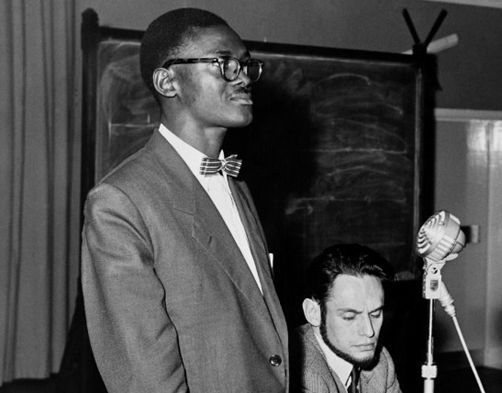
Le dirigeant congolais Patrice Lumumba. On ignore quand et où cette photo a été prise. © AFP
«Farouchement indépendant», Dag Hammarskjöld «s’était aliéné les grandes puissantes du Conseil de sécurité (de l’ONU) (…) en soutenant le processus de décolonisation», observe le Guardian. En juillet 1960, il avait ainsi répondu à la demande d’aide du Premier ministre congolais, Patrice Lumumba, en envoyant des casques bleus pour mettre fin à l’insurrection. Mais devant la lenteur de l’opération onusienne, Patrice Lumumba s’était ensuite tourné vers les grandes puissances et avait obtenu l’aide de l’URSS. Ce qui «a précipité l’émergence de la Guerre froide en Afrique avec la très vive inquiétude des Etats-Unis de voir, pour la première fois, l’URSS tenter de s’engager loin de ses frontières», rapporte l’historien américain Philip Muehlenbeck.
Evidemment, tout cela ne dit pas si l’ancien secrétaire général de l’ONU a lui aussi été victime d’un assassinat. Une chose est sûre : sa politique congolaise avait irrité les Américains et les Britanniques. «Parmi la liste des coupables potentiels figurent les gouvernements de Rhodésie, du Katanga, du Royaume Uni et d’Afrique du Sud ; des intérêts économiques ouest-européens (pour la plupart des compagnies minières belges et françaises) opérant au Katanga ; des mercenaires étrangers actifs dans cette région ; et des éléments incontrôlés de la CIA» et des services britanniques, affirme Philip Muehlenbeck.
Alors s’agit-il d’un «complot», comme le pense l’historien ? La nouvelle enquête de l’ONU permettra peut-être de le savoir. Pour l’instant, la mort du diplomate suédois reste, comme celle de Patrice Lumumba (assassiné, dit-on, par des Congolais assistés par des Belges), l’«un des grands mystères de l’histoire contemporaine africaine».
Le secrétaire général de l'ONU, Dag Hammarskjöld (à droite), avec le Premier ministre libanais Sami al-Sohl au Liban en 1958 © AFP - SAMI SOLH ALBUM
TVN24 - Poland (Polish)
"Doprowadzić do ustalenia pełnej prawdy". Chcą ostatecznie wyjaśnić katastrofę z 1961 r.
Sekretarz generalny ONZ Ban Ki Mun ogłosił, że okoliczności katastrofy lotniczej z 1961 r. w wyniku której zginął Dag Hammarskjold, stojący wówczas na czele ONZ, powinny zostać ponownie przebadane w wyniku pojawienia się wielu nowych faktów.
To nasza wspólna odpowiedzialność, aby doprowadzić do ustalenia pełnej prawdy, uwzględniającej warunki i okoliczności, w efekcie których doszło do tragicznej śmierci Daga Hammarskjolda oraz osób mu towarzyszących
Ban Ki Mun
Sekretarz generalny w wyniku prowadzonego dotychczas dochodzenia uzyskał informacje, które mogą dowodzić, że katastrofa samolotu z delegacją ONZ lecącą do dzisiejszej Demokratycznej Republiki Kongo w 1961 r. była wynikiem zamachu, co uzasadnia podjęcie dalszych badań nad jej przyczynami - informuje we wtorkowym wydaniu "New York Times".
Celem badań nad katastrofą, wokół której powstało wiele teorii spiskowych, ma być ostateczne ustalenie prawdy. Ban Ki Mun zwrócił się z apelem do rządów państw świata o pomoc w śledztwie i udostępnianie materiałów, które mogłyby okazać się pomocne. Stany Zjednoczone oraz Wielka Brytania odmawiały dotychczas ujawnienia utajnionych dokumentów - opisuje nowojorski dziennik.
- To nasza wspólna odpowiedzialność, aby doprowadzić do ustalenia pełnej prawdy, uwzględniającej warunki i okoliczności, w efekcie których doszło do tragicznej śmierci Daga Hammarskjolda oraz osób mu towarzyszących - powiedział obecny sekretarz generalny.Badają katastrofę
Nie spadł, ale go zestrzelili?
W marcu Ban Ki Mun na wniosek Zgromadzenia Ogólnego ONZ utworzył panel, zadaniem którego było zbadanie okoliczności katastrofy lotniczej oraz hipotez o zestrzeleniu samolotu. Przewodniczącym panelu został Mohammed Chande Othman z Tanzanii, członkami Kerryn Macaulay z Australii oraz Henrik Larsen z Danii.Na jaw wyszły...czytaj dalej »
Szwed Dag Hammarskjold, drugi sekretarz generalny w historii ONZ, poniósł śmierć razem z piętnastoma innymi członkami delegacji ONZ w katastrofie lotniczej w nocy z 17 na 18 września 1961 r. na terytorium brytyjskiego protektoratu Północnej Rodezji (dzisiejsza Zambia). Hammarskjold odbywał podróż do Katangi, prowincji będącej obecnie częścią DRK, gdzie miał się podjąć wynegocjowania rozejmu w toczącym się konflikcie. Pośmiertnie, w 1961 r., został odznaczony Pokojową Nagrodą Nobla.(PAP)
Knack - Belgium (Flemish)
VN beveelt verder onderzoek naar luchtaanval tegen Dag Hammarskjold
De VN wil dat onderzoek naar de mysterieuze dood van haar secretaris-generaal Dag Hammarskjold in 1961 wordt verdergezet, met de klemtoon op onderzoek naar een luchtaanval tegen het vliegtuig waarin Hammarskjold reisde, toen hij in Congo wilde bemiddelen. Bij de mogelijke daders worden ook Belgen genoemd.
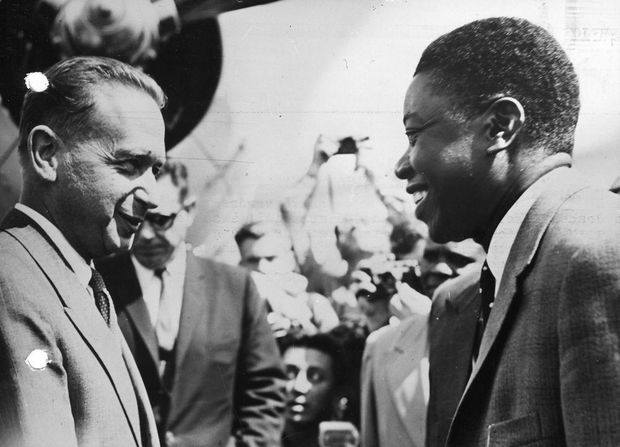
Dag Hammarskjold met Moïse Tshombe © BELGA
De 56-jarige Dag Hammarskjold kwam op 18 september 1961 om het leven toen zijn DC-6 nabij de stad Ndola, in toenmalig Noord-Rhodesië, het huidige Zambia, crashte. Hammarskjold was op weg naar Congo, voor een vredesmissie.
Een van de 15 andere inzittenden overleefde de ramp enkele dagen, maar hij kon geen samenhangend relaas geven. Getuigen had het over een of meerdere vliegtuigen die het toestel van de VN-secretaris achterna zaten. In een van versies is er sprake van eenFouga Magister, bestuurd een Belgische piloot.
In een rapport dat de VN maandag vrijgaf, en dat in maart was besteld, wordt een overzicht gegeven van wat bekend is.
In een bijgevoegde brief schrijft de huidige secretaris-generaal, Ban Ki-moon, dat er voldoende reden is om met "de hypothese van een luchtaanval of een ander feit van buitenaf rekening te houden".
De andere verklaringen, zoals kaping, sabotage of vermoeidheid van de piloot, worden in het rapport terzijde geschoven.
Ik ben van mening, aldus Ban Ki-moon, "dat een nieuw onderzoek nodig is om definitief vast te leggen wat is gebeurd".
Radiostilte over radioboodschap
De secretaris-generaal riep lidstaten op om geheime documenten vrij te geven. In het verleden weigerden Groot-Brittannië en de VS hun informatie te delen.
Er zijn twee onafhankelijke getuigen die een radioboodschap van de NSA, de Amerikaanse inlichtingendienst, hebben gehoord, waarin, volgens de ene getuige, door de piloot werd gezegd dat hij het toestel had geraakt, en volgens de andere dat "de Amerikanen" het toestel hadden neergehaald.
NSA wil de desbetreffende documenten tot dusver niet vrijgeven, al zegt de organisatie wel dat ze geen sporen van die radioboodschap heeft teruggevonden.
Een lid van de Britse geheime dienst MI6 zou ter plekke geweest zijn, maar ook de Britten willen hun documenten niet vrijgeven.
Katanga
Noord-Rhodesië was destijds een Brits protectoraat. Dag Hammarskjold was op vredesmissie naar Congo. Daar had Moïse Tshombe, met Belgische steun, de onafhankelijkheid van grondstoffenrijk Katanga uitgeroepen en waren gevechten uitgebroken tussen Katangese separatisten (met huurlingen) en een VN-macht die in principe niet zou vechten. De VN-secretaris-generaal wilde met Tshombe onderhandelen.
Een van de versies is dat een piloot van rebellen van Katanga, de Belg José Magain, verantwoordelijk was voor het neerschieten van het toestel.
Susan Williams, een Britse specialist die een rapport over de crash schreef, had het dan weer over "een Belgiche piloot bij naam van Beukels", die het vliegtuig per ongeluk zou hebben neergeschoten, nadat hij geprobeerd het het elders te doen landen.
Er is ook vaak beweerd dat mijnbedrijven zoals Union Minière wilden beletten dat de VN een rol speelde in de regio.
(Belga/RR)
Le Vif - Belgium (French)
L'ONU veut rouvrir l'enquête sur la mort mystérieuse de Dag Hammarskjold
En 1961, le deuxième secrétaire général de l'ONU, le Suédois Dag Hammarskjold, décède mystérieusement. L'Organisation des Nations Unies a estimé lundi qu'il fallait poursuivre les recherches et prendre en compte l'hypothèse d'une attaque aérienne contre son avion.
- 103Fois partagé
- Partager sur Facebook
- Partager sur Twitter
- Partager sur Google+
- Partager sur LinkedIn
- Envoyer par e-mail
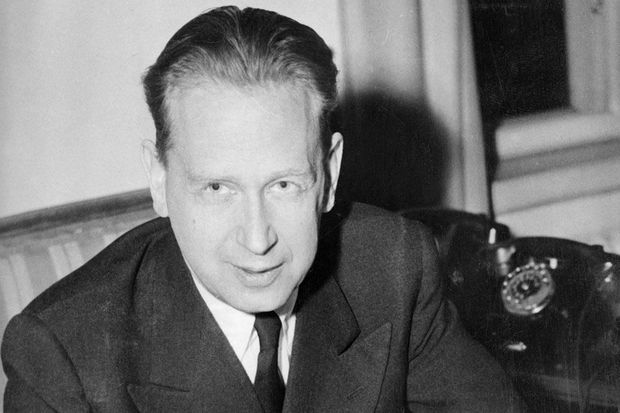
Dag Hammarskjold © EPA
Dag Hammarskjold avait été tué le 18 septembre 1961 quand son DC-6 s'était écrasé près de Ndola, en Rhodésie du Nord, l'actuelle Zambie. Des témoins ont évoqué la présence d'un ou plusieurs avions à réaction qui auraient pris en chasse le DC-6 et l'auraient abattu - on parle souvent d'un Fouga Magister piloté par un Belge.
Dans un rapport rendu public lundi, une équipe d'experts indépendants nommés par l'ONU jugent que ces témoignages ont "une valeur probante modérée". Dans une lettre annexée au rapport, l'actuel secrétaire général, Ban Ki-moon, souligne que ces nouveaux éléments "ont une valeur probante suffisante pour faire de l'attaque aérienne ou d'un autre fait d'origine extérieure une hypothèse à prendre en compte". Le rapport écarte ou minimise d'autres explications (détournement, sabotage de l'appareil, fatigue de l'équipage).
Ban Ki-moon se déclare "d'avis qu'une nouvelle enquête serait nécessaire pour établir définitivement les faits". Il "exhorte de nouveau les Etats membres à divulguer et à déclasser les informations dont ils pourraient disposer", en particulier sur une éventuelle attaque.
Les enquêteurs expliquent avoir demandé en vain aux autorités américaines et britanniques certains documents classés secrets émanant de leurs services de renseignement. Il s'agit notamment d'enregistrements de conversations dans le cockpit de l'avion et de messages radio que l'Agence nationale de sécurité américaine (NSA) aurait réalisés en 1961.
Dans les archives de la CIA et de la NSA
Washington a répondu avoir fouillé les archives de la CIA et de la NSA et "n'avoir trouvé aucun document correspondant à (cette) description", selon une lettre annexée au rapport. Par contre d'autres documents concernant cette affaire se trouvent dans les archives mais ils "restent top secret et ne peuvent être divulgués".
Le gouvernement britannique a lui aussi opposé une fin de non-recevoir aux demandes de la commission d'enquête. Elles concernaient un agent du MI6 (services de renseignement britanniques) présent sur place au moment de l'arrivée de l'avion de Dag Hammarskjold en Rhodésie du Nord, qui était alors un protectorat britannique.
En réponse, précise le rapport, le gouvernement britannique a répondu "ne pas être en mesure de rendre publics pour des raisons de sécurité" les documents demandés et n'avoir pas retrouvé d'autres "documents pertinents".
L'ONU a nommé en mars dernier une équipe d'experts indépendants afin de rouvrir l'enquête sur les circonstances mystérieuses du décès du diplomate suédois. Il effectuait alors une mission de paix au Congo nouvellement indépendant et devait rencontrer le dirigeant du Katanga qui avait fait sécession du Congo et proclamé son indépendance, Moïse Tshombe.
A la demande de la Suède, l'Assemblée générale de l'ONU avait décidé en décembre 2014 que des experts indépendants devaient poursuivre le travail d'investigation déjà entamé par la Commission Hammarskojld en 2013.
L'équipe d'experts était dirigée par le Tanzanien Mohamed Chande Othman, ancien procureur en chef du Tribunal international pour le Rwanda. Il était assisté de Mme Kerryn Macaulay, représentante de l'Australie au Conseil de l'Organisation de l'aviation civile internationale, et de Henrik Ejrup Larsen (Danemark), un expert en balistique de la police danoise.
Des témoins interrogés par la commission avaient évoqué la présence d'un autre appareil qui aurait tiré sur le DC-6 - il est souvent question d'un Fouga Magister de la rébellion katangaise piloté par un Belge, José Magain (décédé en janvier 2003).
Nederlands Dagblad - Netherlands (Dutch)
Ban Ki-moon wil uitsluitsel over dood Hammarskjöld
Secretaris-generaal van de Verenigde Naties Dag Hammarskjöld kwam in 1961 om toen zijn vliegtuig neerstortte. De oorzaak van de crash is nooit opgehelderd. | beeld ap
New York
Secretaris-generaal Ban Ki-moon van de Verenigde Naties wil dat er een nieuw onderzoek komt naar de dood, in 1961, van zijn voormalige ambtgenoot Dag Hammarskjöld. Er is volgens Ban voldoende nieuwe informatie die dit rechtvaardigt.
De Zweed Hammarskjöld en vijftien medereizigers kwamen in de nacht van 17 op 18 september 1961 om het leven toen het vliegtuig waarin zij zaten, neerstortte in een bos bij Ndola, in het toenmalige Noord-Rhodesië (nu Zambia). Al vrij kort na het neerstorten van de DC6 deden geruchten de ronde dat er sprake was van moord. Hammarskjöld was een groot voorsta …
Tin Tuc - Vietnam (Vietnamese)
Cái chết bí ẩn của một người hùng Liên hợp quốc-Kỳ cuối
HƠN NỬA THẾ KỶ NGHI VẤN
Ngay sau khi thảm kịch xảy ra, một loạt các cuộc điều tra đã được tiến hành, song đáng chú nhất là những bằng chứng của Ủy ban điều tra do nghị sỹ Anh David Lea đứng đầu thực hiện. Nhóm điều tra này phát hiện rằng những thông tin mà phi công nhận được từ đài kiểm soát đều chính xác và không có dấu hiệu rằng thiết bị đo độ cao của máy bay bị hư hỏng, càng hạ cánh được hạ thấp ở vị trí thích hợp và khóa lại, các cánh con của máy bay được lắp đặt đúng vị trí. Nói cách khác, lỗi do phi công như kết luận của cuộc điều tra ban đầu của Rhodesia là không thực sự thuyết phục.
Nhóm tìm kiếm tại hiện trường vụ rơi máy bay.
Ngoài ra, theo Ủy ban điều tra này, có “bằng chứng từ nhiều hơn một nguồn... rằng các lỗ thủng giống các vết đạn được nhìn thấy trên thân máy bay bị bốc cháy”.
Một bài báo của Thời báo New York ngày 20/9/1961 đã dẫn lời Tổng thống Mỹ Harry S. Truman nói với các phóng viên: “Dag Hammarskjold đang trên đường hoàn thành việc gì đó khi họ giết ông ấy. Chú ý tôi nói là ‘khi họ giết ông ấy’”.
31 năm sau tai nạn, năm 1992, hai người từng là các đại diện của LHQ tại Katanga là Conor Cruise O'Brien và George Ivan Smith đã gửi một bức thư cho tờ Guardian nói có bằng chứng rằng chiếc máy bay vô tình bị những tay lính đánh thuê bắn rơi. Người này cho rằng lính đánh thuê đã bắn cảnh cáo với mục đích làm máy bay đổi hướng nhưng lại trúng thân máy bay và làm nó bị rơi.
Năm 1998, Ủy ban hòa giải và sự thật của Nam Phi (TRC) dưới sự chỉ đạo của Tổng giám mục Desmond Tutu, đã cho phát hành các bức thư cho rằng Cơ quan Tình báo Trung ương Mỹ (CIA), Cơ quan An ninh Anh (MI5) và tình báo Nam Phi có liên quan trong vụ máy bay của ông Hammarskjold gặp nạn. Văn phòng ngoại vụ Anh sau đó cho biết những lá thư đều là những thông tin không chính xác.
Duy nhất thi thể TTK Hammarskjold không bị bốc cháy trong số các nạn nhân của vụ tai nạn đêm 18/9/1961.
Năm 2005, quan chức LHQ đầu tiên tới hiện trường máy bay rơi, Giám đốc thông tin quân sự của LHQ tại Congo vào năm 1961, ông Bjorn Egge, trả lời phỏng vấn báo Aftenposten rằng ông đã nhìn thấy một lỗ thủng giống như một vết đạn bắn trên trán của TTK Hammarskjold. Tuy nhiên những bức ảnh chụp thi thể Hammarskjold, thi thể duy nhất không bị cháy trong số các nạn nhân, được công bố sau đó đã “xóa sạch” dấu vết này. Ngoài ra, ông Edge cho rằng TTK Hammarskjold đã cố lết khỏi hiện trường khi tay ông còn nắm chặt những ngọn cỏ, lá cây. Qua đó, viên tướng người Na Uy này chắc chắn rằng TTK vẫn còn sống sau vụ tai nạn, và đã bị giết chết sau đó.
Câu hỏi đặt ra là tại sao đến tận thời điểm này, ông Bjorn Egge mới tiết lộ những chi tiết quan trọng đến vậy. Và liệu có thế lực to lớn nào đó đã ngăn cản và che giấu sự thực về thảm kịch hàng không ở châu Phi năm 1961.
Nhiều tác giả đã nghiên cứu và viết về những sự thực lạ lùng của thảm kịch hàng không cướp đi mạng sống của người đứng đầu LHQ bấy giờ Hammarskjold, trong đó có Tiến sĩ người Anh Susan Williams. Năm 2011, 50 năm sau vụ tai nạn, bà đã xuất bản cuốn sách “Ai giết Hammarskjold?”, với giả thuyết đầy thuyết phục rằng máy bay của ông Hammarskjold đã bị lính đánh thuê của nhà nước ly khai Katanga bắn hạ. Bà Williams đặt ra những nghi vấn về các bức ảnh bị giả mạo và khẳng định có những sự thật bị che giấu.
Một bằng chứng quan trọng khác xuất phát từ nhân viên tình báo Mỹ đã về hưu Charles Southall. Buổi sáng trước khi tai nạn xảy ra, Charles Southall đóng quân tại căn cứ của Cơ quan an ninh quốc gia Mỹ (NSA) ở CH Síp.
Khoảng 9 giờ tối hôm đó, Southall nhận được một cuộc gọi yêu cầu nghe một đoạn phát thanh vì có “điều thú vị” sắp diễn ra. Southall miêu tả việc nghe một đoạn băng ngay trước nửa đêm trong đó có tiếng một phi công: “Tôi thấy một chiếc máy bay vận tải hạ thấp độ cao. Toàn bộ đèn sáng. Phải, đó là Transair DC6. Đó là một chiếc máy bay.”
Southall nghe thấy tiếng như của một phát đạn pháo và rồi: “Tôi đã bắn nó. Nó bốc cháy. Nó đang rơi”. Do CH Sip ở cùng múi giờ với Ndola, Ủy ban điều tra trên kết luận rằng có thể Southall đã thực sự nghe được băng ghi âm từ Ndola.
Cùng năm 2011, nhiều tài liệu tổng hợp các bằng chứng về vụ tai nạn được The Guardian đào xới lại. Một nhân viên cứu hộ Thụy Điển, ông Goran Bjorkdahl, đã tiếp tục cuộc điều tra độc lập về vụ tai nạn mà cha mình, người từng có mặt ở Zambia vào thập niên 1970 đã thực hiện. Ông Bjorkdahl đã phỏng vấn nhiều nhân chứng là những người khai thác than trong vùng, trong đó các nhân chứng khai nhìn thấy một máy bay thứ hai theo sau chiếc “Albertina”.
Ông Bjorkdahl khẳng định không còn nghi ngờ gì về việc chiếc "Albertina" đã bị một máy bay chiến đấu nhỏ hơn bắn hạ.
Một nhân chứng nữa là Dickson Mbewe, (84 tuổi năm 2011) trả lời The Guardian: “Chúng tôi thấy một máy bay nhỏ hơn áp sát máy bay lớn với vận tốc lớn và phát hỏa tạo ra một ánh sáng lóa”. Ông Mbewe còn cho biết khoảng 5 giờ sáng ngày 19 đã đến lò than ở gần hiện trường tai nạn. Ông thấy các binh sĩ và cảnh sát đã giải tán người dân. Theo báo cáo chính thức, đống đổ nát của máy báy chỉ được phát hiện lúc 3 giờ chiều. Có vẻ Ủy ban điều tra của Anh cũng như chính quyền Bắc Rhodesia đã bưng bít thông tin, cũng như phong tỏa hiện trường khá lâu trước khi công bố các thông tin chính thức. Người sống sót duy nhất sau khi chiếc DC6 rơi là Harold Julian vệ sĩ của TTK, từng là một cựu lính thủy đánh bộ Mỹ. Trước khi chết, Julian nói rằng có một vụ nổ trước khi chiếc máy bay rơi.
Harold được chăm sóc trong một buồng riêng dưới sự giám sát chặt chẽ của các bác sĩ người Anh. Báo cáo chính thức cho hay người này tử vong vì những vết thương nặng. Tuy nhiên, Mark Lowenthal, một bác sĩ điều trị cho Julian tại Ndola, nói với ông Bjorkdahl rằng anh ta có thể được cứu sống nếu được cứu chữa kịp thời.
Rất nhiều nghi vấn xung quanh thảm kịch hàng không ở châu Phi vào năm 1961 chưa được sáng tỏ, và mới đây TTK LHQ Ban Ki Moon đã tuyên bố tái điều tra vụ tai nạn cướp đi sinh mạng của “người hùng” Hammarskjold.
UNA Germany - Germany (German)
Politik und Sicherheit
Weitere Untersuchungen zum Tod von Dag Hammarskjöld
Expertenkommission legt Bericht vor
Generalsekretär empfiehlt weitere Ermittlungen
Henning Melber
(Dieser Beitrag setzt den Bericht von Henning Melber, Neue Untersuchung zum Tod von Dag Hammarskjöld, VN, 1/2014, S. 28f., fort.)
Wie genau der zweite UN-Generalsekretär Dag Hammarskjöld in Ausübung seines Amtes ums Leben kam, ist nach wie vor ungeklärt. Im September 2013 legte eine unabhängige Kommission, bestehend aus vier international renommierten Juristinnen und Juristen, (Hammarskjöld-Kommission) einen Bericht über die möglichen Ursachen des Flugzeugabsturzes vor (siehe Bericht des Autors in VN, 1/ 2014). Durch den Absturz in der Nacht vom 17. auf den 18. September 1961 kamen Hammarskjöld und 15 weitere Menschen an Bord der Maschine ums Leben. Der Kommissionsbericht wurde dem UN-Generalsekretär Anfang Oktober 2013 überreicht. Am 21. März 2014 machte dieser den Bericht allen UN-Mitgliedstaaten zugänglich (UN Doc. A/68/800) und regte den Empfehlungen der Kommission folgend an, die Generalversammlung mö- ge eine offizielle Folgeuntersuchung beschließen.
Folgeuntersuchung
Ein entsprechender Antrag Schwedens wurde mit Unterstützung zahlreicher anderer Länder am 29. Dezember 2014 mit Resolution 69/246 einstimmig angenommen. In Folge dessen ernannte Ban Ki-moon am 16. März 2015 eine dreiköpfige unabhängige Expertenkommission. Sie bestand aus dem tansanischen Generalstaatsanwalt Mohamed Chande Othman als Leiter sowie dem dänischen Ballistiker Henrik Larsen und der austra- lischen Luftfahrtexpertin Kerryn Macaulay. Mit einem Budget von 500 000 US-Dollar ausgestattet, sollten sie die Schluss-folgerungen der Hammarskjöld-Kommis- sion prüfen und darüber befinden, inwieweit eine neuerliche Untersuchung durch die UN gerechtfertigt sei. Nach Befragungen in einigen Ländern, einschließlich Interviews mit noch lebenden Augenzeugen in Sambia, überreichte die Kommission ihren Bericht am 11. Juni 2015 dem Generalsekretär.
In seinem Übergabeschreiben, das zusammen mit dem Bericht als Anhang zu einem Brief des Generalsekretärs am 2. Juli den Mitgliedstaaten übermittelt wurde (UN Doc. A/70/132), vertritt Othman die Auffassung, dass die weitere Befassung der UN mit dem Flugzeugabsturz erforderlich sei, um weiter bestehende Informationslücken zu schließen. Zu diesen gehörten klassifizierte Dokumente im Besitz von Mitgliedstaaten und deren Institutionen. Dieses vorhandene, weiterhin geheim gehaltene Material könne Aufschluss über den Absturz und die möglichen Umstände und Ursachen geben.
Die Expertengruppe bewertete die von der Hammarskjöld-Kommission geprüften Aspekte, die im Zusammenhang mit den Ursachen für den Absturz des Flugzeugs stehen könnten. Dabei ging es insbesondere um die Prüfung der Hypothese, ob ein Luftangriff von einer zweiten Maschine oder andere Formen der Einwirkung als mögliche Absturzursachen gelten können. Die Expertengruppe fand hinreichend neue Informationen, die eine mögliche Fremdeinwirkung als Absturz-ursache nicht ausschließen.
Die bislang vorherrschende offizielle Erklärung, dass es sich bei dem Absturz um eine Folge von Übermüdung des Flugpersonals gehandelt habe, wird ausdrücklich als ebenso unbewiesen eingestuft wie andere Vermutungen. Dem Bericht zufolge gibt es Indizien, die nicht ausschließen, dass zum Zeitpunkt des Absturzes mehr als ein Flugzeug in der Luft war und dass die abstürzende Maschine vor dem Aufprall bereits in Flammen stand. Auch Hinweise auf einen möglichen Funkverkehr, der weitere Aufschlüsse über den Hergang zuließe, sowie Zusatzinformationen zur tatsächlichen Luftwaffen-Kapazität der Provinzregierung von Katanga könnten bei der Suche nach der Wahrheit eine Rolle spielen.
Des Weiteren gelangte die Gruppe zu dem brisanten Schluss, dass die von Hammarskjöld seinerzeit benutzte Kodierungsmaschine CX-52 zur internen Kommunikation absichtlich so konstruiert worden sei, dass sie auch den Mitschnitt durch die National Security Agency (NSA) und andere ausgewählte Ge- heimdienste erlaubt hätte. Damit wurde eine gegenwärtig diskutierte Praxis der Bespitzelung auch seinerzeit zu einem anscheinend probaten Mittel, um sich Zugang zu Informationen zu verschaffen.
Empfehlungen und weitere Fragen
In seiner Zusammenfassung des Berichts vertritt der Generalsekretär die Auffassung, dass eine weitere Untersuchung durch die UN nötig sei. Er nimmt zur Kenntnis, dass einzelne Mitgliedstaaten die Anfragen nicht substanziell oder gar nicht beantwortet hätten oder den Geheimhaltungsvermerk gewisser Dokumente trotz des großen zeitlichen Abstands zum Vorfall beibehielten und die Einsicht verweigerten. Er zieht aus diesem Sachverhalt und den Empfehlungen der Expertengruppe den Schluss, dass es möglicherweise vorhandenes, aber nicht zugängliches Material gibt. Er fordert die Mitgliedstaaten auf, ihre Suche nach relevantem Material fortzusetzen und die noch ausstehenden Anfragen nach spezifischen Informationen so bald wie möglich zu beantworten.
In einem Schreiben des britischen Außenministeriums vom 10. Juni 2015 an den Leiter der Expertengruppe wurde bedauert, dass eine vollständige Herausgabe des angeforderten Materials aus Gründen der nationalen Sicherheit nicht mög- lich sei. Die USA hatten bereits tags zuvor Othman darüber informiert, dass die NSA zwar entsprechende Dokumente gefunden hätte, diese jedoch weiterhin der obersten Geheimhaltungsstufe unterlägen.
Dies veranlasste Alan Cowell in einem Artikel in der New York Times vom 10. Juli 2015 zu fragen, welche Geheimnisse so groß seien, dass sie sogar fast 55 Jahre danach noch verschwiegen werden müssten. Sollte es tatsächlich Aufzeichnungen der chiffrierten Kommunikation Hammarskjölds in den Archiven der westlichen Geheimdienste geben, wären diese vermutlich höchst aufschlussreich hinsichtlich seiner damaligen Verhandlungsstrategie. Diese konnte den Konflikt um Kon- go und dessen enorme Bodenschätze nicht beenden. Er kostete vielmehr auch sein Leben und das vieler anderer im Dienste der Vereinten Nationen.
China Radio International - China
UN to Probe Plane Crash of Hammarskjold in 1961
The file photo shows then-UN Secretary-General Dag Hammarskjold during a visit to the Democratic Republic of Congo in 1961. [Photo: china.com.cn]
There is sufficient reason to investigate if the aircraft carrying then-UN Secretary-General Dag Hammarskjold on an African peace mission in 1961 was shot down by another plane, killing all aboard, UN Secretary-General Ban Ki- moon said on Monday.
A panel, which Ban established in March to examine new allegations regarding the crash, near Ndola in Northern Rhodesia, now Zambia, of the Swedish-operated Douglas DC6 carrying Hammarskjold and 15 others, recently sent its finding to the secretary-general who sent them on Monday to the 193-member UN General Assembly along with his recommendations to investigate some of the allegations further.
However, Ban said the panel determined Hammarskjold was not assassinated after surviving the crash and that there was no hijacking or sabotage. The panel found Hammarskjold and 14 other passengers died on the night of the Sept. 17 to 18, 1961 crash of the propeller-driven aircraft. SE-BDY and the 16th victim died five days later.
Hammarskjold, the second UN secretary-general, was trying to negotiate a cease-fire involving secessionists from Katanga province of the Democratic Republic of Congo.
"The panel assigned moderate probative value" to "new information relevant to the hypothesis of an aerial attack or other interference as a possible cause or causes of the crash," Ban said in his letter to General Assembly President Sam Kutesa.
The reasons cited were "Nine new eyewitness accounts that they observed more than one aircraft in the air at the same time as SE- BDY made its approach to Ndola, and that any additional aircraft were jets, or that SE-BDY was on fire before it impacted the ground or that it was fired upon or otherwise actively engaged by other aircraft present," he said.
There were also claims two persons hearing "alleged intercepts or reading transcripts of intercepts of radio transmissions relating to a possible aerial or ground attack on SE-BDY" and there was additional information that has emerged on the air capability of the provincial government of Katanga (province) in 1961 and its use of foreign military and paramilitary personnel," the secretary-general said.
Additionally, the panel also found "moderate probative value" to allegations encrypted communications from the Hammarskjold aircraft were intercepted and that crew fatigue could have been "a contributing factor to the crash," he said.
The report also said new information it considered "calls into question the official account of the time of discovery of the crash site and the behavior of various officials and local authorities."
"It is my view that a further inquiry or investigation would be necessary to finally establish the facts," Ban said, urging member states "to disclose, declassify or otherwise allow privileged access to information that they may have in their possession related to the circumstances and conditions resulting in the deaths of the passengers of SE-BDY."
He urged "any relevant records that remain classified more than 50 years after the fact, are declassified or otherwise made available for review ... by any eminent person or persons whom the Assembly may wish to entrust with this mandate. I consider this our solemn duty to my illustrious and distinguished predecessor, Dag Hammarskjold, to the other members of the party accompanying him and to their families."
The Japan Times - Japan
Inquiry looks into whether aerial attack caused U.N. chief’s 1961 fatal plane crash in Africa
UNITED NATIONS – A United Nations inquiry into a 1961 plane crash that killed then-U.N. Secretary-General Dag Hammarskjold found that new information pointing to an aerial attack or threat bringing down the aircraft warrants further investigation.
Hammarskjold — a Swede elected as the world body’s second chief in 1953 — was killed along with 15 others while on his way to broker a truce in Katanga in what is now Democratic Republic of Congo. The plane crashed in Northern Rhodesia, now Zambia.
“The panel ultimately found significant new information that it assessed as having sufficient probative value to further pursue aerial attack or other interference as a hypothesis of the possible cause of the crash,” Secretary-General Ban Ki-moon wrote in a letter to the General Assembly released on Monday.
The three-member panel asked for specific information from Belgium, France, Germany, South Africa, the United States and Britain during its three-month inquiry into the September 1961 crash, but said not all requests were entirely satisfied.
The panel said its ultimate conclusion was that to establish the “whole truth” the United Nations needed access to “classified material and information held by Member States and their agencies that may shed further light on this fatal event and its probable cause or causes.”
Ban has asked his chief legal counsel to follow up with states “on the unfulfilled aspects of the panel’s requests.” Ban agreed that further investigation would be needed to establish the facts of the plane crash.
Several theories have surrounded the death of Hammarskjold, who was posthumously awarded the Nobel Peace Prize in 1961.
The panel said new details related to claims by mercenaries and others that they shot down the plane lacked credibility, while a claim about possible sabotage using explosives was only “weakly supported.” A hijacking theory was not supported.
But new information about an aerial attack or threat could “provide an appreciable lead in pursuing the truth of the probable cause or causes of the air crash and tragic deaths.”
That new information included eyewitnesses saying they saw more than one aircraft in the sky or that Hammarskjold’s plane was on fire before it hit the ground or was fired upon by other aircraft and two men who listened to or read a transcript of an intercept of radio transmissions relating to what they believe was as attack on the plane that led to its crash.
There was also additional new information on the air capability of the provincial Government of Katanga in 1961 and its use of foreign military and paramilitary personnel.
The 193-member U.N. General Assembly asked Ban in December to appoint the independent panel of exerts to examine new information. The experts were from Tanzania, Australia and Denmark.
Tanzania Today - Tanzania (Swahili)
JAJI MKUU OTHMAN CHANDE KUOGOZA JOPO HURU KUHUSU KIFO CHA DAG HAMMARSKJOLD
Na Mwandishi Maalum, New York
Katibu Mkuu wa Umoja wa Mataifa, Ban Ki Moon amemteua Jaji Mkuu wa Jamhuri ya Muungano wa Tanzania , Mhe. Mohamed Chande Othman
Katibu Mkuu wa Umoja wa Mataifa, Ban Ki Moon amemteua Jaji Mkuu wa Jamhuri ya Muungano wa Tanzania , Mhe. Mohamed Chande Othman (pichani) kuongoza jopo huru la wataalam watakaopitia taarifa mpya kuhusu kifo cha Bw. Dag Hammarskjold ambaye aliwahi kuwa Katibu Mkuu wa Umoja wa Mataifa
(pichani) kuongoza jopo huru la wataalam watakaopitia taarifa mpya kuhusu kifo cha Bw. Dag Hammarskjold ambaye aliwahi kuwa Katibu Mkuu wa Umoja wa Mataifa.
“ Katibu Mkuu anayofuraha ya kutangaza kwamba amewateua wafuatao kuwa wajumbe wa jopo huru la wataalamu. Bw. Mohamed Chande Othman kutoka Jamhuri ya Muungano wa Tanzania ambaye atakuwa mkuu wa jopo hilo. Wajumbe wengine ni Bw. Kerryn Macaulay kutoka Australia na Bw. Henrik Ejrup Larsen kutoka Denmark” inasomeka taarifa iliyotolewa na Umoja wa Mataifa siku ya JumatatuUteuzi wa Jopo hilo unatokana na Azimio namba 69/246 la Baraza Kuu la Umoja wa Mataifa lililopitishwa tarehe 29 mwezi Desemba 2014 ambalo lilimtaka Katibu Mkuu wa Umoja wa Mataifa kuteua jopo la wataalam huru ili kuchunguza na kutathimin thamani ya taarifa mpya ( probative value)zinazohusiana na kifo cha Katibu Mkuu Dag Hammarskjold pamoja na watu waliofuatana naye.Bw. Dag Hammarskjold na ujumbe wake alipoteza maisha katika ajali ya ndege iliyotokea mwaka 1961 wakati akitokea Jamhuri ya Kidemokrasia ya Kongo.Baadhi ya Majukumu ya Jopo hilo huru la wataalamu pamoja na mambo mengine yatakuwa kupitia na kutathmini thamani ya taarifa mpya ambazo Kamisheni ya Hammarskjold imeziwasilisha kwa Katibu Mkuu Ban Ki Moon. Vile vile litatathmini taarifa mbalimbali ambazo zimetolewa na nchi wanachama na vyanzo vingine.
Jopo hilo la wataalam huru litaanza kazi yake mwisho mwa mwezi huu wa March ( 30 March) na linatarajiwa kuwasilisha taarifa yake kwa Katibu Mkuu si Zaidi ya tarehe 30 mwezi June mwaka huu.
Michuzi
Sputnik News International - Russia
UN Chief: Case of Crash that Killed Dag Hammarskjöld Should be Reopened
UN Secretary-General Ban Ki-moon has claimed that plane crash that killed former Secretary-General Dag Hammarskjold in 1961 should be re-investigated, as new evidence pertaining to the accident has been uncovered.
A panel appointed by Ban revealed new information suggesting that the plane transporting the second Secretary-General of the United Nations to Katanga, part of present-day Democratic Republic of Congo, may have come under an aerial attack. The plane crashed in Northern Rhodesia, now Zambia, taking lives of 15 people along with Hammarskjold.
"The panel ultimately found significant new information that it assessed as having sufficient probative value to further pursue aerial attack or other interference as a hypothesis of the possible cause of the crash," Secretary-General Ban wrote in a letter to the General Assembly released on Monday.
Specific information about the 1961 plane crash was requested from Belgium, France, Germany, South Africa, the United States and Britain by the three-member panel, which said not all of its requests were satisfied.
The panel asked for access to all "classified material and information held by Member States and their agencies that may shed further light on this fatal event and its probable cause or causes," to uncover the “whole truth” about the tragedy.
There have been several theories surrounding the death of Hammarskjold, and the panel determined that neither sabotage using explosives, nor hijacking were fully credible.© SPUTNIK/ ILIYA PITALEVThe fresh information included eyewitness testimony, some of which claimed there were two planes in the sky, or that Hammarskjold’s aircraft was on fire before it hit the ground.
Addressing a theory about crew fatigue, the panel said that it “does not, in and of itself, explain the cause of the crash or the extent, if at all, to which fatigue was a contributing factor to the crash.”
Ban called on officials of all involved states to “disclose, declassify or allow privileged access to the secretary general to information they may have.”
The Guardian - UK
UN says evidence justifies further inquiry into 1961 Hammarskjöld crash
UN secretary general died aboard aircraft in what is now Zambia in 1961
US and UK refuse to release classified documents
New information uncovered by a UN panel on the death of former secretary-general Dag Hammarskjöld should be investigated to establish whether his plane was attacked just before it crashed in southern Africa, the UN chief said on Monday.
After receiving the report, the secretary-general, Ban Ki-moon, said “a further inquiry or investigation would be necessary to finally establish the facts” surrounding the mysterious crash more than 50 years ago.
The panel “found new information, which it assessed as having moderate probative value, sufficient to further pursue aerial attack or other interference as a hypothesis of the possible cause of the crash”, said UN spokesman Farhan Haq.
The answers may lie in classified documents from the United States and Britain that the panel was unable to consult, despite requests for access.
Ban said he would follow up on the requests.
The UN’s second secretary-general, Hammarskjöld died when his plane crashed on 17 or 18 September 1961 near Ndola, in Northern Rhodesia, now known as Zambia.
The 56-year-old Swedish diplomat was on his way to negotiate a ceasefire for mining-rich Katanga province in what was then the Republic of the Congo, which had proclaimed independence from Belgium.
The three-person panel spoke to witnesses in Zambia who testified that there was more than one aircraft in the air when the plane made its approach to Ndola, or that the plane was on fire before it hit the ground.
These accounts seemed to corroborate information contained in a 2013 report by a separate commission that concluded that there was “convincing evidence” that the plane was shot down as it prepared to land.
A former US air force security officer, Paul Abram, told the panel that he heard transmissions about the shooting down of an aircraft near Congo while serving at a National Security Agency listening post in Greece.
The panel said it could not authenticate Abram’s claims.
The US government wrote in a letter to the panel last month that a search had not revealed any documents on radio transmissions but added that other files classified as top secret from the National Security Agency would not be released.
Among the new information uncovered by the panel was a declassified report from a senior British diplomat to a secret service agent, Neil Ritchie, who details how he helped the Katanga leader Moise Tshombe travel to Ndola for his meeting with Hammarskjöld.
The report did not mention the possible crash but “its existence and content serves as new information about the presence of the British intelligence agency in the area”, said the UN panel.
The British government responded last month in a letter to the panel that it would not be able to provide more information on the case due to security concerns.
The UN General Assembly in late December adopted a resolution, drafted by Sweden, that called for the new investigation to finally shed light on the top diplomat’s death.
Led by the Tanzanian prosecutor Mohamed Chande Othman, the panel also included Kerryn Macaulay of Australia and Henrik Larsen of Denmark.
CBC News - Canada
Dag Hammarskjöld death details may still be sealed, UN says
Governments asked to open secret files on 1961 plane crash that killed 16
Posted:Jul 11, 2015 5:00 AM ET
Last Updated:Jul 11, 2015 5:00 AM ET
Searchers walk through the wreckage of the plane carrying UN secretary general Dag Hammarskjöld. It crashed in 1961 during his peace mission to Congo. The incident remains one of the Cold War's greatest unsolved mysteries. Associated Press
Key evidence about whether someone shot down the plane in which former United Nations secretary general Dag Hammarskjöld was killed in 1961 may remain sealed in documents held by several governments, a UN panel says.
The panel has submitted its report to UN chief Ban Ki-moon, saying that in order to get at "the whole truth," the UN may need to "address remaining information gaps, including in the existence of classified material and information held by member states and their agencies'' that may help reveal the cause of the crash.
It is worth investigating whether the aircraft was shot down, the panel says. The crash killed Hammarskjöld and 15 others, including Canadian Alice Lalande,
It adds that this conclusion is based on new information including eyewitness testimony that there was a second aircraft – possibly a jet – in the sky close to Hammarskjöld's plane right before it went down.
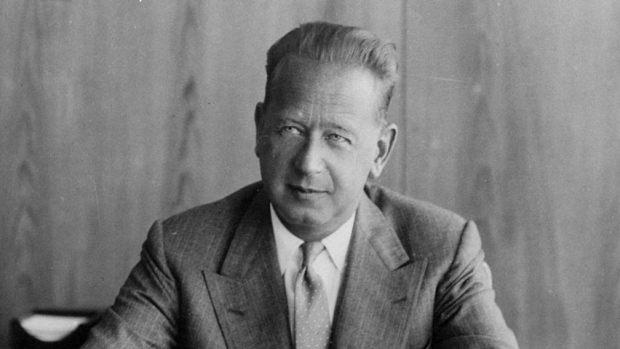
In 1961 the plane carrying UN Secretary General Dag Hammarskjöld crashed in the African bush during a peace mission to Congo. (Associated Press)
Now it is up to the UN General Assembly to decide how to proceed, says Jan Eliasson, the UN deputy secretary general.
Hammarskjöld's plane crashed in a forested area about 14 km from the Ndola airport in Northern Rhodesia, now Zambia.
The 56-year-old Swedish diplomat was on his way to meet Congolese secessionist leader Moise Tshombé, who had declared the mineral-rich southeastern province of Katanga an independent state. The Congo had gained independence from Belgium just one year earlier, and Hammarskjöld was on a peace mission to try to keep the country united.
The three-member UN panel sent requests for information to Belgium, France, Germany, South Africa, the United States and the United Kingdom.
But Ban notes in a letter to the General Assembly that "in some cases, member states have not provided a substantive response, have not responded at all or have maintained the classified status of the documents in question despite the passage of time.''
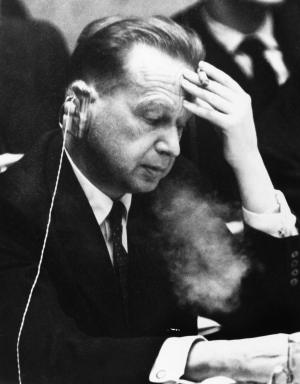
On Feb. 15, 1961, Hammarskjöld attends a meeting at the UN headquarters in New York. That was seven months before he died in what is now Zambia, a death still shrouded in mystery. (Associated Press)
Correspondence between the independent panel and the countries is included in an annex to the June report. "I intend to follow up with the member states concerned,'' Ban said.
The Swedish mission to the UN put forward a unanimously adopted resolution last December which ultimately led to Ban appointing the independent three-member panel to review new information that has come to light in recent years.
"I'm not saying it is a national trauma today but it certainly was at the time, and not just in Sweden. It was a huge event in the world given Dag Hammarskjöld's stature as an international statesman,'' said Sweden's ambassador to the United Nations, Olof Skoog.
"It's similar to John F. Kennedy getting shot in our national psyche. So it's huge, it's big!''
Skoog hopes Ban's latest call will bear fruit.
So far the requests have been at a "technical level," he said. "You know, you leave it to the archivist [to decide] whether this is classified or not. I think now the call has to be on a much more political level,'' he said. "And there is going to be a political cost for holding back that kind of information.''
Skoog said Sweden is committed to keeping the issue on the UN agenda.
Eliasson, the deputy secretary general, said the UN will take in any new information, but ultimately the decision on the way forward will have to come from the General Assembly.
"There are a number of options,'' he said. "You can reopen the investigation from the early '60s, you can ask for a new investigation, you can ask for an external investigator that pursues these issues.''
Eliasson was a young officer stationed on a Swedish naval ship in the Baltic Sea one day after his 21st birthday when he heard Hammarskjöld had died.
"Hammarskjöld was the person that symbolized Sweden's role in the world. So when he died it was an enormous shock for our nation,'' said Eliasson. "Every Swede knows exactly where they were on that day.''
He said the morning he learned of Hammarskjöld's death was the morning he decided to join the UN.


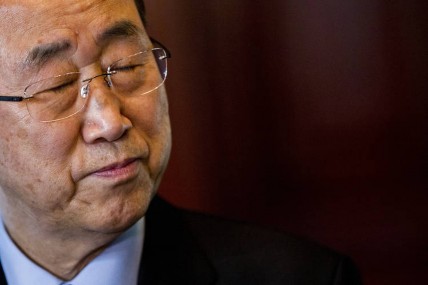
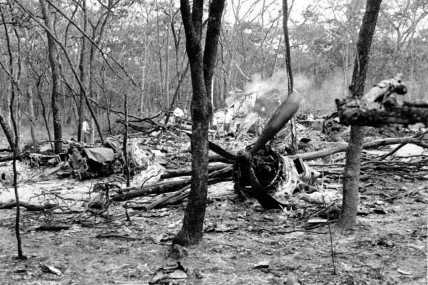
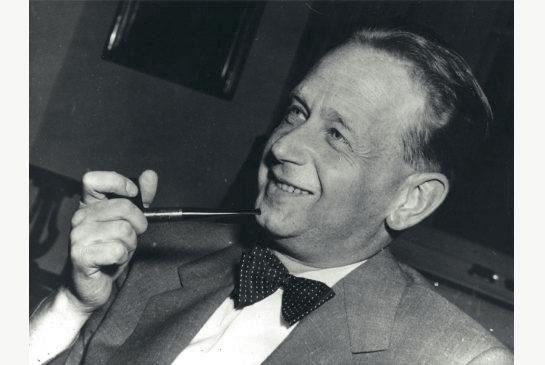
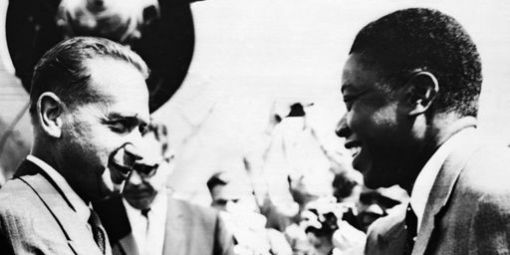
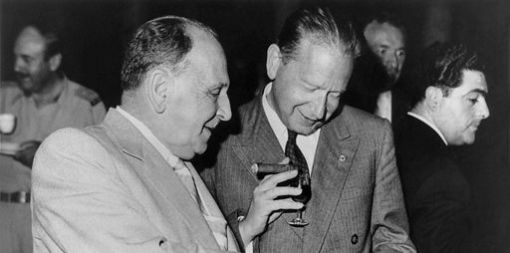
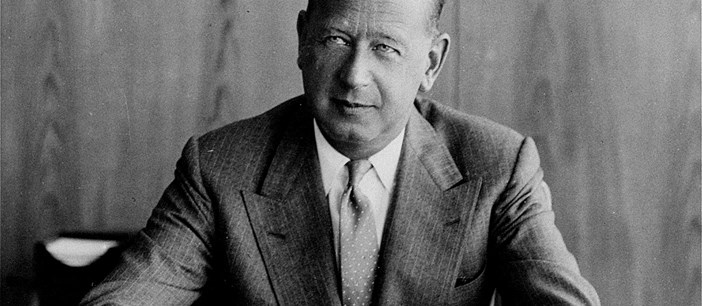
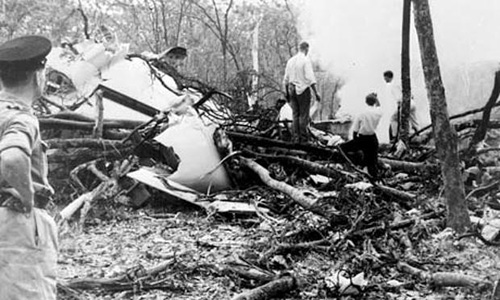
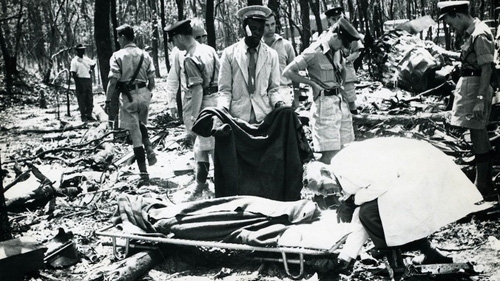
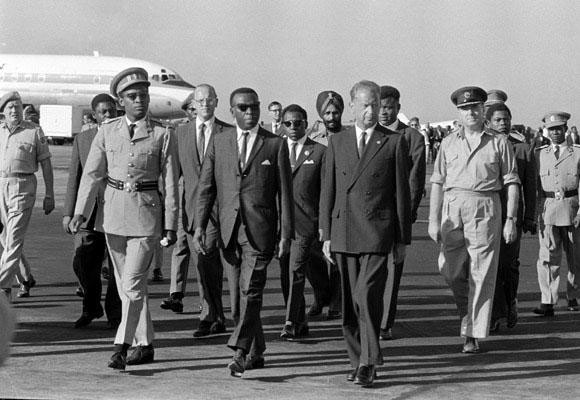
.jpg)
